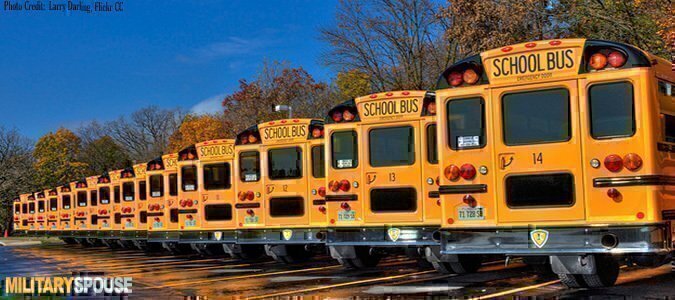Our school-aged children have sent in their teachers’ gifts, signed the yearbooks and dumped the contents of their backpacks onto the living room floor. However, the end of school means more to military families than sleeping in, summer camps and pool parties. For many of us, the end of school usually means PCS season is in full swing, packers are coming, emotional goodbyes and another new school for our children.
Changing schools can be a complicated and an emotionally draining task for many families. It can be difficult to remember the bottomless list of things to compile or ask the school when your household is being moved and community support system is changing. We’ve compiled a list to help you stay focused on a smooth transition. Here are nine things every parent should know when their children are changing schools.
- You have rights! Know your rights as a military family. Public education policy and curriculum can vary wildly between states. It’s important that parents are armed with knowledge before they transfer to a new school. The Military Interstate Children’s Compact Commission (MIC3) is an agreement between all 50 states to provide consistent education and enrollment policies for military-connected children in every school district.
The Compact addresses key educational transition issues that military families frequently encounter such as enrollment, placement, attendance, eligibility and graduation. There is a compressive list of educational issues that every school must follow on MIC3’s website www.MIC3.net.
- Military Child Education Coalition (MCEC). MCEC is an organization dedicated to supporting education issues affecting military-connected children. It is an excellent resource for materials, programs, support, scholarships and more for your family and school. Take a read and scour its website for possible connections to your new school district. MCEC offers training to school district officials, consultants to assist in your school transition and online resources to help you find the right school. Check out its website for tools you can use before you more. militarychild.org
- Create an education binder for your child. An education binder is a military child’s educational life story. The binder does more than exhibit a transcript – it shares the child’s educational story and should include important documents, notes and tests. Below are a few things that should be included in your child’s education binder:
Work samples,
Report cards,
Standardized test scores,
Transcripts highlighting different curricula at different schools,
Teacher conference documentation,
Teacher-to-teacher communication,
Notes regarding deployments and homecomings, and
A picture of your child so counselors and teachers can put a face with a name.
You can create your own binder at home and be sure to hand carry it with you when you move. When you arrive at your new school, give the binder to the school counselor to review before you register so they can properly place your child with the right teacher or class setting.
Once the binder is returned from the counselor, give the binder to your child’s teacher within the few weeks of school to review and return. The education binder is a valuable advocacy tool for parents to when moving. The detailed work you put into organizing the binder will help paint a complete picture of your child’s educational needs. . To find out more about the education binder and to download a free template, visit www.FamiliesOnTheHomeFront.com
- New School Information. Before moving, parents should find out as much as they can before they unpack. Many schools have limited office hours during the summer. All schools have specific dates and requirements to registration a new student and parents need to be prepared to help smooth the school transition. Also, most schools offer new student orientations or a “back to school” event BEFORE school starts. Attending these events will help families adjust faster and help them prepare for the social side of school. Parents should contact the school or visit their website for details. Click here for a complete PCS checklist for changing schools.
- Find the Insider. It’s always nice to find that person who will give you the inside scoop on the school, teachers and policies. Start your insider search with the school PTA or PTO board. Most schools have them, and board members tend to be the people who volunteer the most at school and, therefore, understand the ins and outs. Reach out on social media via the school Facebook page, web pages and email too. Attempt to establish a connection before you arrive. And, if you can find another military family to connect with the chances are pretty high they will be willing to give you as much information as possible. Don’t forget about your local School Liaison Officer (SLO). They can usually connect you with other military families in your area.
- Stay connected. Before you move, think about how to stay connected to your local friends, teachers and school. It’s important that children remain connected to their friends – and it’s incredibly easy through technology these days. Staying connected to friend far away allows them have some social stability during a transition. There are amazing online games that can help kids still play together after a move. For a list of kid friendly (and parent approved games) check out this list of suggested games that are perfect for keeping friendships connected.
As for teachers, have your children drop their favorite teacher a postcard or note letting them know well they are doing at their new school. Reconnecting with teachers gives your own child a chance to tell how they’ve grown in their own words.
- Summer programs. The best way to get plugged in socially when you arrive at a new location is through local summer programs. Before you move, find the list of summer camps, programs, sports and classes offered in your like local parks and recreation, Boys & Girls Club, YMCA or local college campuses. Sign up for a few classes or camps before you arrive so your family has something to look forward to besides unpacking. This is a great way to meet local friends and fellow parents and connect quickly to the community.
- Do the Homework. Unfortunately, not all schools have the same educational standards. Before you move, find out what curriculum the new school district is using. Find workbooks or reading lists to practice over the summer. Familiarizing your family with what the expectations are before school begins saves hours of frustration in the classroom. See the Common Core Adoption Map.
In most cases, military-connected children spend the first six to ten weeks in a waiting period with their academics (e.g. either waiting for the curriculum to catch up to child or for the child is playing catch up to the current curriculum. Either way, children continue to be in transition weeks after school begins. Do your homework before school starts!
- Stay positive. According to the study published in the Military Medicine and the Association of Military Surgeons of the United States, the most contributing factor to having a well-adjusted military child is the relationship with mom (or dad, depending on who the civilian parent might be.)
Whether you are mom or dad, the civilian member of your home offers the greatest gift to a military child. We become the buffer to the stressful factors that most military kids must endure.
According to the study, “…a positive mother-child relationship may reduce children’s experience of loneliness and serve as a buffer against the ill effects of children’s experience in social isolation.”
Researchers found that if a maternal figure (could be mom or dad) in the home had a positive attitude toward military life and a strong marriage, the children were more likely to feel secure and adjust well to new environments. It also found that if the family unit as a whole enjoyed spending time together and invested in the family relationship, the military child was less likely to feel anxiety and depression. The bottom line – the better the relationship you have between yourself and your child, the better chance they will have adjusting to new situations during relocation.
Read Next: 7 No-Fail Beaty Tips For Homecoming




